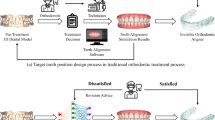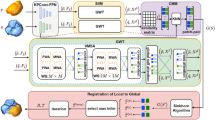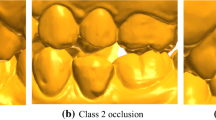Abstract
Orthodontic malocclusion treatment is a procedure to correct dental and facial morphology by moving teeth or adjusting underlying bones. It concentrates on two key aspects: the treatment planning for dentition alignment; and the plan implementation with the aid of external forces. Existing treatment planning requires significant time and effort for orthodontists and technicians. At present, no work successfully automates the process of tooth movement in orthodontics. In this study, we leverage state-of-the-art deep learning methods and propose an automated treatment planning process to take advantage of the spatial interrelationship between different teeth. Our method enables to exploit a 3-dimensional spatial transformation architecture for malocclusion treatment planning with 4 steps: (1) sub-sampling the dentition point cloud to get a critical point set; (2) extracting local features for each tooth and global features for the whole dentition; (3) obtaining transformation parameters conditioned on the features refined from the combination of both the local and global features and, (4) transforming initial dentition point cloud to the parameter-defined final state. Our approach achieves 84.5% cosine similarity accuracy (CSA) for the transformation matrix in the non-augmented dataset, and 95.3% maximum CSA for the augmented dataset. Our approach’s outcome is proven to be effective in quantitative analysis and semantically reasonable in qualitative analysis.
Access this chapter
Tax calculation will be finalised at checkout
Purchases are for personal use only
Similar content being viewed by others
References
Chetverikov, D., Svirko, D., Stepanov, D., Krsek, P.: The trimmed iterative closest point algorithm. In: Object Recognition Supported by User Interaction for Service Robots, vol. 3, pp. 545–548. IEEE (2002)
Cui, Z., Li, C., Wang, W.: Toothnet: automatic tooth instance segmentation and identification from cone beam CT images. In: Proceedings of the IEEE Conference on Computer Vision and Pattern Recognition, pp. 6368–6377 (2019)
Deng, H., et al.: An automatic approach to reestablish final dental occlusion for 1-piece maxillary orthognathic surgery. In: Shen, D., et al. (eds.) MICCAI 2019. LNCS, vol. 11768, pp. 345–353. Springer, Cham (2019). https://doi.org/10.1007/978-3-030-32254-0_39
Dimberg, L., Lennartsson, B., Arnrup, K., Bondemark, L.: Prevalence and change of malocclusions from primary to early permanent dentition: a longitudinal study. Angle Orthod. 85(5), 728–734 (2015)
Dimberg, L., Lennartsson, B., Söderfeldt, B., Bondemark, L.: Malocclusions in children at 3 and 7 years of age: a longitudinal study. Eur. J. Orthod. 35(1), 131–137 (2013)
Djeu, G., Shelton, C., Maganzini, A.: Outcome assessment of invisalign and traditional orthodontic treatment compared with the American board of orthodontics objective grading system. Am. J. Orthod. Dentofac. Orthop. 128(3), 292–298 (2005)
Jaderberg, M., Simonyan, K., Zisserman, A., et al.: Spatial transformer networks. In: Advances in Neural Information Processing Systems, pp. 2017–2025 (2015)
Kravitz, N.D., Kusnoto, B., BeGole, E., Obrez, A., Agran, B.: How well does invisalign work? A prospective clinical study evaluating the efficacy of tooth movement with invisalign. Am. J. Orthod. Dentofac. Orthop. 135(1), 27–35 (2009)
Lima, R.M.A., Lima, A.L.: Case report: long-term outcome of class II division 1 malocclusion treated with rapid palatal expansion and cervical traction. Angle Orthod. 70(1), 89–94 (2000). https://doi.org/10.1043/0003-3219(2000)070<0089:CRLTOO>2.0.CO;2
Mavreas, D., Athanasiou, A.E.: Factors affecting the duration of orthodontic treatment: a systematic review. Eur. J. Orthod. 30(4), 386–395 (2008). https://doi.org/10.1093/ejo/cjn018
Moenning, C., Dodgson, N.A.: Fast marching farthest point sampling. Technical report University of Cambridge, Computer Laboratory (2003)
Murata, S., Lee, C., Tanikawa, C., Date, S.: Towards a fully automated diagnostic system for orthodontic treatment in dentistry. In: 2017 IEEE 13th International Conference on e-Science (e-Science), pp. 1–8. IEEE (2017)
Nielsen, I.L.: Vertical malocclusions: etiology, development, diagnosis and some aspects of treatment. Angle Orthod. 61(4), 247–260 (1991)
Proffit, W.R., Fields Jr., H.W., Sarver, D.M.: Contemporary Orthodontics. Elsevier Health Sciences. Elsevier, Amsterdam (2006)
Qi, C.R., Su, H., Mo, K., Guibas, L.J.: PointNet: deep learning on point sets for 3D classification and segmentation. In: Proceedings of the IEEE Conference on Computer Vision and Pattern Recognition, pp. 652–660 (2017)
Qi, C.R., Yi, L., Su, H., Guibas, L.J.: PointNet++: deep hierarchical feature learning on point sets in a metric space. In: Advances in Neural Information Processing Systems, pp. 5099–5108 (2017)
Thilander, B., Pena, L., Infante, C., Parada, S.S., de Mayorga, C.: Prevalence of malocclusion and orthodontic treatment need in children and adolescents in Bogota, Colombia. An epidemiological study related to different stages of dental development. Eur. J. Orthod. 23(2), 153–168 (2001)
Tian, S., Dai, N., Zhang, B., Yuan, F., Yu, Q., Cheng, X.: Automatic classification and segmentation of teeth on 3D dental model using hierarchical deep learning networks. IEEE Access 7, 84817–84828 (2019)
Wu, W., Chen, H., Cen, Y., Hong, Y., Khambay, B., Heng, P.A.: Haptic simulation framework for determining virtual dental occlusion. Int. J. Comput. Assist. Radiol. Surg. 12(4), 595–606 (2016). https://doi.org/10.1007/s11548-016-1475-3
Xia, Z., Gan, Y., Chang, L., Xiong, J., Zhao, Q.: Individual tooth segmentation from CT images scanned with contacts of maxillary and mandible teeth. Comput. Methods Programs Biomed. 138, 1–12 (2017)
Xu, X., Liu, C., Zheng, Y.: 3D tooth segmentation and labeling using deep convolutional neural networks. IEEE Trans. Visual Comput. Graph. 25(7), 2336–2348 (2018)
Acknowledgement
Thanks are due to AceDental Software Technology for providing the clinical data and the valuable discussion. This work was supported in part by the National Natural Science Foundation of China under Grant 61872241 and Grant 61572316, in part by the Science and Technology Commission of Shanghai Municipality under Grant 18410750700, Grant 17411952600, and Grant 16DZ0501100.
Author information
Authors and Affiliations
Corresponding author
Editor information
Editors and Affiliations
Rights and permissions
Copyright information
© 2020 Springer Nature Switzerland AG
About this paper
Cite this paper
Li, X. et al. (2020). Malocclusion Treatment Planning via PointNet Based Spatial Transformation Network. In: Martel, A.L., et al. Medical Image Computing and Computer Assisted Intervention – MICCAI 2020. MICCAI 2020. Lecture Notes in Computer Science(), vol 12263. Springer, Cham. https://doi.org/10.1007/978-3-030-59716-0_11
Download citation
DOI: https://doi.org/10.1007/978-3-030-59716-0_11
Published:
Publisher Name: Springer, Cham
Print ISBN: 978-3-030-59715-3
Online ISBN: 978-3-030-59716-0
eBook Packages: Computer ScienceComputer Science (R0)





